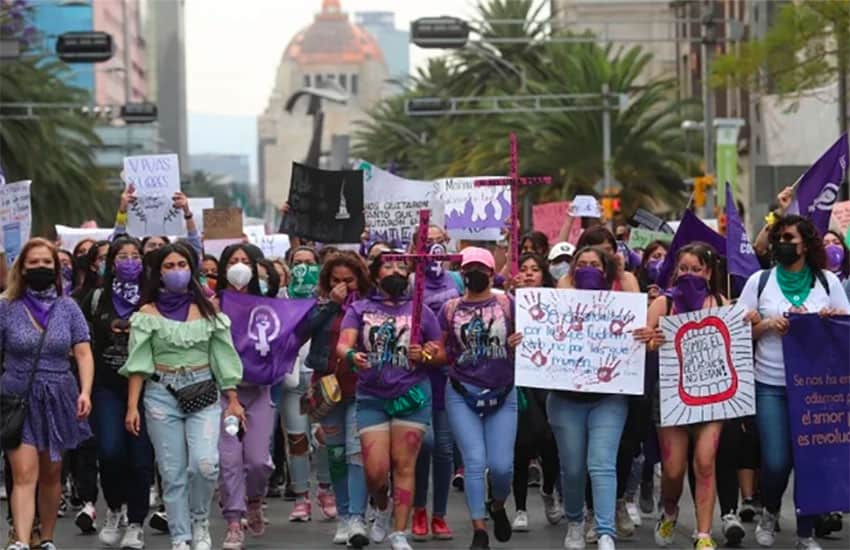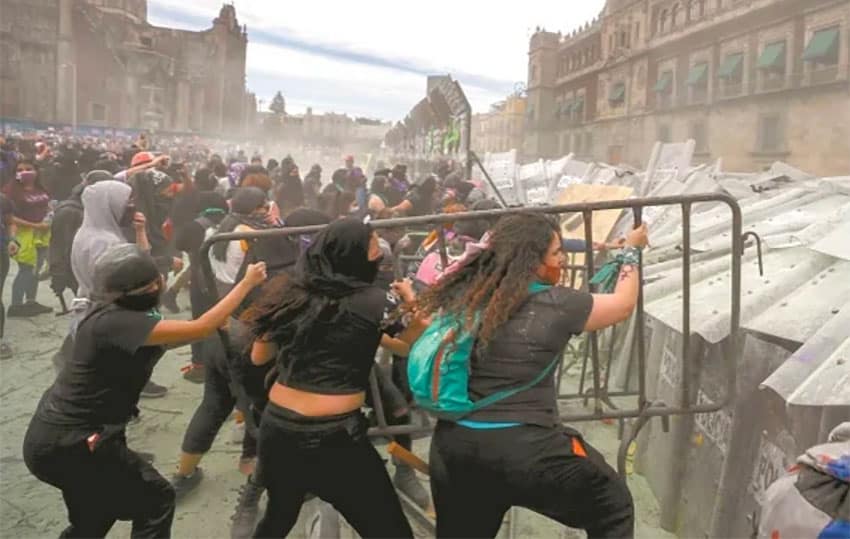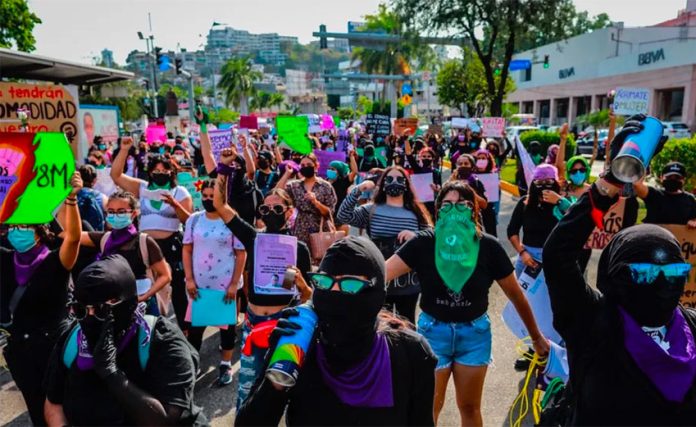Approximately 20,000 women took to the streets in Mexico City on Monday to demand justice in cases of rape, femicide and other gender crimes and an end to the violence that claimed the lives of an average of 10 women per day last year.
Chanting slogans such as “enough impunity already” and “not one woman less,” the participants in the International Women’s Day protest marched through the streets of central Mexico City to the National Palace in the historic center.
This year’s event, about one-quarter of the size of the massive march in 2020, was spurred by anger at President López Obrador over his support for accused rapist Félix Salgado Macedonio, who was chosen as the ruling Morena party’s candidate for governor of Guerrero despite the allegations of several women.
Some women shouted “a rapist will not be governor” as they marched and warned the government they would make their views clear when Mexicans go to the polls to elect federal, state and municipal representatives on June 6.
“Aggressors must go to jail, not into power” and “President, break the [chauvinist] pact” were among the messages written on placards.

Anger at the president’s ongoing support for a man accused of rape, the lack of justice for women victims and the government’s perceived inaction on women’s rights was exacerbated by the installation of a three-meter-high “macho wall of shame” around the National Palace to protect the seat of executive power, which doubles as López Obrador’s residence.
The erection of the metal barrier, which was turned into a memorial for victims of femicide, proved that the government is more concerned about protecting a building than the lives of women, feminist activists and victims’ family members denounced.
Anger spilled over into violence as a minority of radical protesters attacked the barrier with hammers, bats and blowtorches and succeeded in pulling a section of it down. Police stationed behind the fence “fired volleys of flash-bang grenades into the crowd, causing several small stampedes,” The New York Times reported.
The Mexico City Security Ministry said 62 police and 19 civilians were injured during Monday’s protest. At least nine police and one protester were taken to hospital for treatment but their injuries were not life threatening. Mexico City authorities said a group of men infiltrated the protest and attacked policewomen.
Four female photojournalists reported that they were attacked and detained by police in the Hidalgo Metro station while on their way to cover the protest. “From the beginning we identified ourselves; however, they beat us, threw us, handcuffed us and held us [in custody],” an EFE photographer said on Twitter.
Police officials said later they had identified the police commander who gave the instruction to arrest the women and that he and other officers had been suspended, the newspaper Milenio reported.

Protesters denounced that police used tear gas against them during confrontations at the metal barrier but government security official Marcela Figueroa denied that was the case, telling a press conference that the authorities didn’t use any kind of irritating substance to repel and disperse people. She said police only used fire extinguishers after Molotov cocktails were hurled at them. Figueroa also said there was evidence that it was in fact protesters who fired tear gas.
At one stage of the protest, panic overtook the zócalo, Mexico City’s main square, when men were spotted on the roof of the National Palace toting what appeared to be high-caliber weapons. But government spokesman Jesús Ramírez said on Twitter that the suspected weapons were drone defenders used to prevent drone flights over the National Palace because it is a “reserved area.” No one on the roof of the National Palace was armed, Ramírez said.
The protest continued into the night, with groups of women continuing to chant anti-government and anti-violence slogans as a bonfire burned in front of the protective metal barrier.
Ivette Granados, a 49-year-old woman who marched with her 16-year-old daughter, told The New York Times that she didn’t support the use of violence by protesters but added that it appeared to be the only way to get the nation to take notice of women’s lengthy fight for equality.
“I have already seen it throughout history in the peaceful marches of women — they did not give any results,” she said.
“I think that these things make governments and people turn around. And even if I don’t agree, life has shown me that only then do they turn around to see these situations,” Granados said.

“Look, I don’t agree to destroy monuments or damage, right? But it is also clear to me that a monument is not worth more than the life of a girl.”
Granados and her daughter, Maria Puente, told the Times they were angry about the daily struggle against sexual abuse that women across Mexico are forced to endure.
“Mother and daughter took turns listing off the assaults they said they had suffered over the years: being grabbed in the street, on the Metro or at a party, and men flashing their genitals at them in public,” the Times said.
Mexico, one of the most dangerous countries in the world for girls and women, has been plagued by femicides and other gender violence for years. There were well over 3,000 murders of women last year, of which more than 900 were classified as femicides, and some 16,000 reported cases of rape.
With impunity in sexual abuse cases still rampant despite López Obrador and his government pledging to provide access to justice for victims of all crimes, some sections of the feminist movement have become increasingly emboldened recently, demonstrating that they are prepared to resort to aggressive tactics to bring attention to the grave situation they face.
Just six months ago, a feminist collective took over the Mexico City headquarters of the National Human Rights Commission and turned it into a shelter for victims of gender-based violence, while acts of vandalism and violence committed by a minority of protesters have marred recent women’s marches.
Many women see their fight against gender violence and the struggle for women’s rights as a matter of life and death.
“We fight today so we don’t die tomorrow,” was one of the slogans chanted during Monday’s march. “Not one more, not one more, not one murdered woman more,” was another.
Source: Milenio (sp), The New York Times (en), El Universal (sp)
